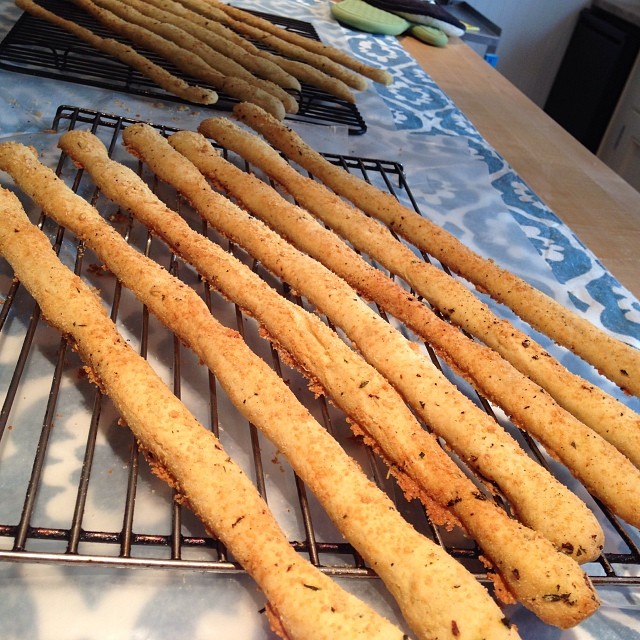
Any time I’ve suggested a tool, a piece of equipment, or a culinary term that’s unfamiliar to you, you can go to Learn to Cook for more information.
Chill the dough after assembling (or after an initial rise) then using the dough cut into small portions. Roll each into a thin rope (using finely ground semolina sprinkled on the work surface. Let rise on parchment or (preferably) on a silicon baking mat sprinkled with semolina (you’ll need two large baking sheets to accommodate all of the grissini-if only one is available, keep one half of the dough, uncut, in the refrigerator). If, after shaping the first sheet pan of grissini, you see some are a bit chubbier than others, one by one, lift them off of the sheet and gently reroll to elongate and correct shape (you can sprinkle the work surface a bit more semolina, to help the strands keep from sticking).
Brush with a garlic-herb-olive oil mixture (the same as used for the focaccia), sprinkle the top with pepper and shredded Parmesan and bake in a preheated 375F oven for about 18 to 20 (rotate the pan during baking) and then allow to sit in a turned off for 10 to 13 minutes or until light golden brown but not overly dark. Remove from the oven and let cool on a wire rack. Serve standing up in a tall glass or vase—or laying down in a basket (traditionally, in northern Italy, grissini is served simply placed directly on the table cloth). If any of the grissini feel at all squishy, put them back in the turned off oven to allow them to dry. (For sesame grissini, shape the same way, but after the strands are thin, sprinkle the work surface with some seeds and a bit more semolina and continue to roll so that some of the seeds sink into the surface of the dough (roll gently). Once shaped and on their sheets, brush the surface with some egg white glaze (1 egg white beaten with a fork and a small splash of water and then strained into another bowl). Sprinkle the tops of the strands with more seeds and some Kosher salt. Bake as directed above.
Brush the grissini with egg white mixed with a bit of water and then strained. Seed the top with sesame seeds, poppy seeds, etc. Bake as described. Those grissini that are simply seeded might need to be baked a bit less since the cheese on the first variation is insulating—go for color and texture.
Drying time will largely depend on the girth of each grissini—so, once the correct color is achieved, let dry as long as needed, checking after 10 minutes. Very thin grissini will not need to bake or dry as long—and will need to be removed early so that they don’t taste bitter or get overly hard.